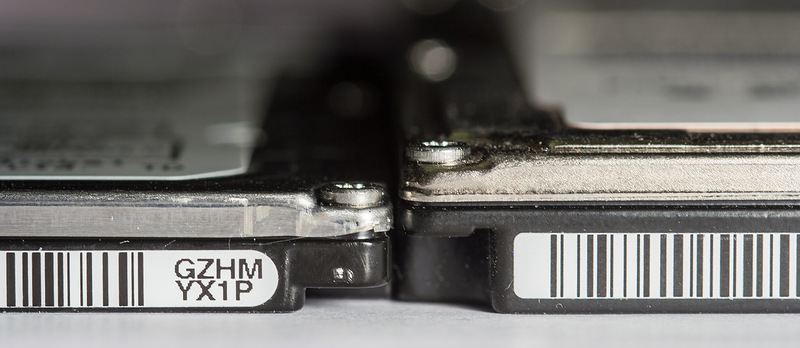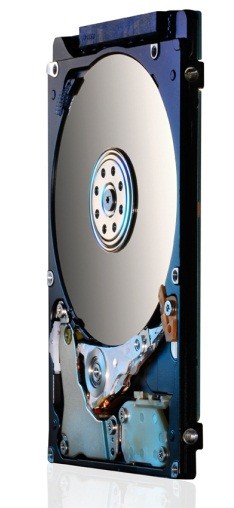The story of two millimeters
This post is dedicated to 2.5-inch 2.5-inch form factor hard drives: these are the most recent models (starting from last year) that started appearing on laptops from various manufacturers. The change, compared to the standard height drives of 9.5 millimeters, seems to be small, but for the most advanced users it caused a lot of emotions. First of all, due to the impossibility (looking ahead to say - temporary) to provide in your laptop storage of more than 500 gigabytes. Indeed, is there any sense? Well, if the new models had a thickness of three millimeters and even fit on tablets. And here - some two millimeters.

Therefore, in the blog of HGST, the largest manufacturer of "seven millimetres", I would like to pay special attention to such hard drives. “Two millimeters minus” is really not a revolutionary change, but thin hard drives appeared on the market just in time. Already thanks to them, more and more models with hybrid storage (SSD + HDD) are now available for sale, providing both speed and volume, and simply laptops with a fairly fast and economical hard drive. Such models are inexpensive (although SSDs have fallen in price, but still give a tangible mark-up), and do not require the owner to carry an external drive with them - in case you want to choose something from your own video library. Expecting in the comments the immoderate holivar “SSD vs HDD”, I will start with a short digression into history.
Our size?
The whole modern computer history (after the truck was no longer needed to transport one hard drive) is accompanied by two main form factors - 3.5 inches (inherited from Floppy drives) for desktop computers and 2.5 for laptops. However, there were exceptions - for example, 5.25-inch hard drives that appeared in the early 80s and briefly revived in the mid-90s. For laptops, at one time a 3-inch form factor was considered - a compromise between volume and dimensions, which, however, did not take off. Hard drives with a size of 1.8 inches or less have disappeared recently - such crumbs can really be placed anywhere, only small plates do not provide either data transfer speed or volume.
Therefore, a 2.5-inch hard drive was and remains the standard for mobile devices. However, why only for mobile? Similar hard drives are used in external drives (3.5-inch boxes still do not correspond to the concept of “portable hard drive”), in game consoles and in corporate storage systems. And this means that in the research centers of all (now a few :) manufacturers of hard drives, this format will be given no less, and maybe more, attention than standard 3.5-inch models.
What does HGST offer?
Model Travelstar Z7K500 is currently available in versions of 250, 320 and 500 gigabytes. The characteristics common to all versions are as follows:
 Interface : SATA 3 6 Gb / s
Interface : SATA 3 6 Gb / s
Data buffer size: 32 MB
With a spindle rotation speed : 7200 rpm
Search time : 13 ms
Number of on / off cycles : 600 000
Power consumption in read / write mode : 1.8 W
Power consumption in standby mode : 1.7 W
Full list of characteristics - in PDF on the HGST website .
All models have one plate for data recording, and are currently one of the fastest “notebook” disks (more than 130 megabytes per second in the sequential read-write test). But much more important is not even speed, but energy consumption parameters. In read-write mode, the power consumption of the model is only 1.8 watts.
2 millimeters is a lot!
No, of course, for monsters 8 cm thick, a thinner hard drive will not do the weather. But for ultrabooks - quite. According to Yandex.Marketat the time of writing, 90 ultrabook models available for sale in Russia were known, with a price tag of 18 to 40+ thousand rubles. The thickness of the models is from 17 to 21 millimeters. In such models, every millimeter counts, so in about half the cases, only SSDs up to 128 gigabytes are used (and the minimum price rises to 25 thousand rubles). In other cases, either a single hard drive or a hybrid storage is used, providing both speed and volume, while maintaining minimal size and weight. Among these models, there are even 15-inch computers weighing 1.8 kilograms. And everyone who constantly carries a computer with them is well aware that it would be nice to reduce these laptop parameters. Thin hard drives are one of the technologies that allows you to do this without having to figure out
What's next?
Thin hard drives give owners of ultrabooks and simply compact models the opportunity not to limit themselves in the amount of data stored - within reasonable limits, but also without the severe restrictions of a typical SSD of 128 gigabytes. Of course, now you can buy a laptop with an SSD of 750 gigabytes or more, only now it will have a corresponding price. The proliferation of hybrid storage models also removes the issue of speed. Moreover, models such as the Z7K500 provide very fast data transfer to the hard disk and vice versa, with speeds of more than 120 megabytes per second on "large" files.
As a result, changing the height of the hard drive by just 2 mm actually extends the life of the hard drives. If it seems to someone that only a few solid state drives will remain, then this is not so :) Moreover, even 7 millimeters is not the limit of possibilities. More recently, five-millimeter hard drives up to 500 gigabytes in size have been announced.
The competition between SSDs and HDDs will continue, but all we can do is use its fruits. Of all the available configurations for a laptop disk system, for me personally, the most profitable is an 80-gigabyte solid-state drive and a 500-gigabyte, constantly available "archive" with all the necessary files. And for you?

Therefore, in the blog of HGST, the largest manufacturer of "seven millimetres", I would like to pay special attention to such hard drives. “Two millimeters minus” is really not a revolutionary change, but thin hard drives appeared on the market just in time. Already thanks to them, more and more models with hybrid storage (SSD + HDD) are now available for sale, providing both speed and volume, and simply laptops with a fairly fast and economical hard drive. Such models are inexpensive (although SSDs have fallen in price, but still give a tangible mark-up), and do not require the owner to carry an external drive with them - in case you want to choose something from your own video library. Expecting in the comments the immoderate holivar “SSD vs HDD”, I will start with a short digression into history.
Our size?
The whole modern computer history (after the truck was no longer needed to transport one hard drive) is accompanied by two main form factors - 3.5 inches (inherited from Floppy drives) for desktop computers and 2.5 for laptops. However, there were exceptions - for example, 5.25-inch hard drives that appeared in the early 80s and briefly revived in the mid-90s. For laptops, at one time a 3-inch form factor was considered - a compromise between volume and dimensions, which, however, did not take off. Hard drives with a size of 1.8 inches or less have disappeared recently - such crumbs can really be placed anywhere, only small plates do not provide either data transfer speed or volume.
Therefore, a 2.5-inch hard drive was and remains the standard for mobile devices. However, why only for mobile? Similar hard drives are used in external drives (3.5-inch boxes still do not correspond to the concept of “portable hard drive”), in game consoles and in corporate storage systems. And this means that in the research centers of all (now a few :) manufacturers of hard drives, this format will be given no less, and maybe more, attention than standard 3.5-inch models.
What does HGST offer?
Model Travelstar Z7K500 is currently available in versions of 250, 320 and 500 gigabytes. The characteristics common to all versions are as follows:
 Interface : SATA 3 6 Gb / s
Interface : SATA 3 6 Gb / s Data buffer size: 32 MB
With a spindle rotation speed : 7200 rpm
Search time : 13 ms
Number of on / off cycles : 600 000
Power consumption in read / write mode : 1.8 W
Power consumption in standby mode : 1.7 W
Full list of characteristics - in PDF on the HGST website .
All models have one plate for data recording, and are currently one of the fastest “notebook” disks (more than 130 megabytes per second in the sequential read-write test). But much more important is not even speed, but energy consumption parameters. In read-write mode, the power consumption of the model is only 1.8 watts.
2 millimeters is a lot!
No, of course, for monsters 8 cm thick, a thinner hard drive will not do the weather. But for ultrabooks - quite. According to Yandex.Marketat the time of writing, 90 ultrabook models available for sale in Russia were known, with a price tag of 18 to 40+ thousand rubles. The thickness of the models is from 17 to 21 millimeters. In such models, every millimeter counts, so in about half the cases, only SSDs up to 128 gigabytes are used (and the minimum price rises to 25 thousand rubles). In other cases, either a single hard drive or a hybrid storage is used, providing both speed and volume, while maintaining minimal size and weight. Among these models, there are even 15-inch computers weighing 1.8 kilograms. And everyone who constantly carries a computer with them is well aware that it would be nice to reduce these laptop parameters. Thin hard drives are one of the technologies that allows you to do this without having to figure out
What's next?
Thin hard drives give owners of ultrabooks and simply compact models the opportunity not to limit themselves in the amount of data stored - within reasonable limits, but also without the severe restrictions of a typical SSD of 128 gigabytes. Of course, now you can buy a laptop with an SSD of 750 gigabytes or more, only now it will have a corresponding price. The proliferation of hybrid storage models also removes the issue of speed. Moreover, models such as the Z7K500 provide very fast data transfer to the hard disk and vice versa, with speeds of more than 120 megabytes per second on "large" files.
As a result, changing the height of the hard drive by just 2 mm actually extends the life of the hard drives. If it seems to someone that only a few solid state drives will remain, then this is not so :) Moreover, even 7 millimeters is not the limit of possibilities. More recently, five-millimeter hard drives up to 500 gigabytes in size have been announced.
The competition between SSDs and HDDs will continue, but all we can do is use its fruits. Of all the available configurations for a laptop disk system, for me personally, the most profitable is an 80-gigabyte solid-state drive and a 500-gigabyte, constantly available "archive" with all the necessary files. And for you?
